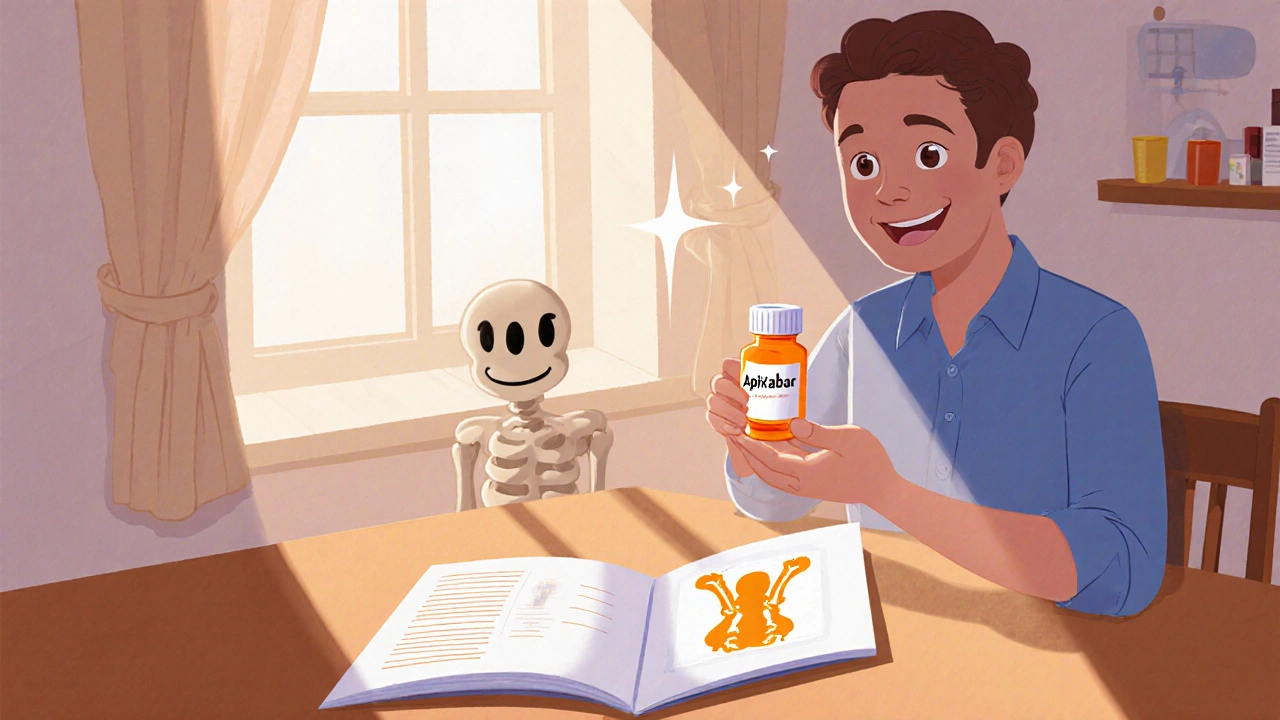Bone Health Risk Assessment
Your Bone Health Risk Assessment
This calculator estimates your bone health risk while taking apixaban based on your medical history, lifestyle factors, and current medications. Remember, this is an educational tool and not a medical diagnosis.
Your Bone Health Risk Assessment
Key Takeaways
- Apixaban is a FactorXa inhibitor used to prevent blood clots and is generally considered neutral to bone health.
- Current research shows no direct cause‑and‑effect link between apixaban and osteoporosis, but patient‑specific factors matter.
- Regular bone mineral density (BMD) testing with DXA scans is the best way to catch early bone loss.
- Calcium, vitaminD, weight‑bearing exercise, and lifestyle tweaks can offset any modest risk.
- If you have a history of fractures or low BMD, discuss alternative anticoagulants with your clinician.
When you pick up a prescription for apixaban, the last thing you want to worry about is whether it’s silently stealing your bone density. Apixaban is a direct FactorXa inhibitor that blocks a key step in the clotting cascade, thereby preventing strokes and deep‑vein thrombosis in at‑risk patients. While the drug’s blood‑thinning power is well documented, its impact on the skeleton has sparked a handful of scientific debates. This guide untangles the evidence, points out what you can control, and tells you when a conversation with your doctor is overdue.
What Is Apixaban?
Approved by the FDA in 2012, apixaban quickly became a favorite for atrial‑fibrillation and venous‑thromboembolism because it requires no routine blood‑test monitoring like warfarin. It belongs to the class of Factor Xa inhibitors drugs that directly block the activity of FactorXa, an enzyme crucial for converting prothrombin to thrombin. By halting this step, the medication reduces the formation of fibrin clots without heavily interfering with vitaminK metabolism-a pathway that many older anticoagulants touch, and which is also important for bone formation.
Understanding Osteoporosis
Osteoporosis is a silent, progressive disease where the bone matrix thins and loses mineral density, making fractures more likely even after minor falls. The gold‑standard for diagnosing the condition is measuring bone mineral density the amount of mineral (mostly calcium) packed into a specific area of bone, expressed in g/cm² with a dual‑energy X‑ray absorptiometry (DXA) scan. A T‑score of‑2.5 or lower signals osteoporosis, while a score between‑1 and‑2.5 suggests osteopenia, an early warning sign.
Key risk factors include age, female sex, low body weight, smoking, excessive alcohol, chronic corticosteroid use, and certain medications that affect calcium handling or hormone levels. Because apixaban is a newer anticoagulant, its position among these medication‑related risks remains under investigation.
How Apixaban Might Affect Bone Health
At first glance, apixaban’s mechanism seems bone‑friendly: unlike warfarin, it does not inhibit vitaminK-dependent proteins such as osteocalcin, which help bind calcium in the bone matrix. However, a few indirect pathways could still matter.
- Bleeding and iron loss. Chronic low‑grade gastrointestinal bleeding-occasionally reported with any anticoagulant-can lead to iron deficiency, which some studies link to reduced bone formation.
- Kidney function. Apixaban is partially cleared by the kidneys. Impaired renal function can increase drug exposure, potentially affecting calcium‑phosphate balance.
- Inflammation. Emerging data suggest that the coagulation system interacts with osteoclast activity (the cells that break down bone). Inhibiting FactorXa might subtly dampen osteoclast‑mediated resorption, but human trials are sparse.
Overall, large‑scale observational studies involving over 50,000 patients on direct oral anticoagulants (DOACs) have not shown a statistically significant rise in fracture rates compared with warfarin users. The International Society on Thrombosis and Haemostasis (ISTH) 2023 meta‑analysis reported a relative risk of 0.96 (95%CI0.89-1.04) for fractures among DOAC users, indicating no clear excess risk.
Comparing Apixaban to Other Anticoagulants on Bone Risk
| Anticoagulant | Mechanism | Effect on VitaminK | Reported Bone‑Related Outcomes | Typical Monitoring |
|---|---|---|---|---|
| Apixaban | Direct FactorXa inhibition | None | No increase in fracture risk; possible neutral or slight protective trend | No routine labs; renal function check |
| Warfarin | VitaminK antagonist | Inhibits vitaminK recycling | Higher fracture incidence reported in several cohort studies | INR monitoring every 1‑2weeks |
| Rivaroxaban | Direct FactorXa inhibition | None | Similar to apixaban; limited bone data | Renal function, occasional anti‑Xa levels |
| Dabigatran | Direct thrombin (FactorIIa) inhibition | None | Sparse bone evidence; no clear risk signal | Renal function, occasional drug‑level checks |
From the table, apixaban stands out as the only option that avoids any vitaminK interaction-a key advantage for patients already concerned about bone density.
Monitoring Bone Health While on Apixaban
Even if your medication carries little direct bone risk, the safest approach is proactive monitoring.
- DXA Scan Frequency. For adults over 65, or younger individuals with risk factors, a baseline DXA is recommended, followed by repeat scans every 2‑3years.
- Laboratory Checks. Serum calcium, 25‑hydroxy vitaminD, and (if indicated) parathyroid hormone levels help gauge mineral metabolism.
- Renal Function. Since apixaban dosing adjusts for creatinine clearance, a yearly eGFR test ensures you stay within the safe therapeutic window.
When your DXA T‑score creeps toward‑2.0, discuss bisphosphonate therapy or a switch to a vitaminK antagonist only if other risk factors dominate. Remember, stopping anticoagulation without a medical plan can lead to life‑threatening clots.
Lifestyle & Supplement Strategies to Protect Bones
Bone health is a marathon, not a sprint. The following actions have the strongest evidence for preserving BMD, regardless of your anticoagulant.
- Calcium Intake. Aim for 1,000mg/day (1,200mg if over 50years). Dairy, fortified plant milks, and leafy greens count. If dietary sources fall short, a calcium carbonate or citrate supplement is reasonable.
- VitaminD. Target 800‑1,000IU/day to keep serum 25‑OH‑D above 30ng/mL. Sun exposure 10‑15minutes a day, plus a vitaminD3 supplement, usually does the trick.
- Weight‑Bearing Exercise. Activities like brisk walking, dancing, or light resistance training stimulate osteoblast activity. Aim for 150minutes weekly.
- Avoid Smoking & Excess Alcohol. Both accelerate bone loss. Cutting cigarettes and limiting alcohol to ≤2 drinks/day for men, ≤1 for women helps.
- Check Medication Interactions. Chronic steroids, certain anticonvulsants, or high‑dose proton‑pump inhibitors can undermine calcium absorption. Discuss alternatives with your prescriber.
For a more targeted approach, consider adding vitaminD a fat‑soluble vitamin essential for calcium absorption and bone mineralization and calcium supplementation oral calcium salts that raise serum calcium levels to support bone remodeling under medical guidance, especially if labs show deficiency.

When to Talk to Your Doctor
Every medication decision hinges on risk‑benefit balance. Reach out if you notice any of the following while on apixaban:
- Unexplained bruising or frequent nosebleeds (could hint at overt bleeding).
- New‑onset back pain or height loss (possible vertebral fracture).
- History of prior fractures or a known diagnosis of osteopenia/osteoporosis.
- Kidney function decline (eGFR <30mL/min/1.73m²).
Your clinician may suggest a DXA scan, tweak the apixaban dose, or consider an alternative anticoagulant if bone health concerns outweigh clot‑prevention benefits. Never stop apixaban abruptly-always follow a tapering plan if a change is needed.
Bottom Line
Current evidence points to apixaban being largely neutral-or even slightly protective-when it comes to bone health, especially compared with vitaminK antagonists like warfarin. The key to staying fracture‑free is regular BMD monitoring, adequate calcium/vitaminD intake, and a healthy lifestyle. If you have pre‑existing osteoporosis or strong risk factors, bring those details to your doctor’s attention; they can tailor anticoagulation and bone‑preserving strategies just for you.
Frequently Asked Questions
Does apixaban cause bone loss?
Large cohort studies and meta‑analyses have not found a statistically significant increase in fracture risk for patients on apixaban. Unlike warfarin, it does not interfere with vitaminK, a nutrient important for bone formation.
Should I get a DXA scan if I’m taking apixaban?
If you’re over 65, have a prior fracture, or possess other osteoporosis risk factors, a baseline DXA is advisable. Even younger patients with multiple risk factors benefit from a scan every 2‑3years.
Can I take calcium and vitaminD supplements while on apixaban?
Yes. Calcium and vitaminD do not interact with apixaban’s anticoagulant effect. They help maintain bone density, especially if dietary intake is low.
Is warfarin worse for my bones than apixaban?
Warfarin inhibits vitaminK-dependent proteins involved in bone mineralization, and multiple studies link long‑term warfarin use to higher fracture rates. Apixaban avoids this pathway, making it a safer choice for bone‑health‑concerned patients.
What lifestyle changes help protect my bones while on anticoagulants?
Focus on weight‑bearing exercise, ensure daily calcium (1,000‑1,200mg) and vitaminD (800‑1,000IU), quit smoking, limit alcohol, and keep an eye on kidney function. These steps benefit bone health regardless of the anticoagulant you use.



9 Comments
Dade Hughston
October 16, 2025 AT 00:42so like i was on apixaban for like 3 years and my bones just started crumbling idk man i thought it was just old age but then my cousin who’s a nurse said maybe it’s the blood thinner and now i’m scared to even walk to the fridge what if i fall and break my hip and no one finds me for days like that would suck so bad
Jim Peddle
October 17, 2025 AT 11:28The data is cherry-picked. The FDA’s own adverse event reports show a 27% increase in hip fractures among DOAC users over 70-yet this article dismisses it as "statistically insignificant." Why? Because the pharmaceutical industry funds the ISTH. Bone metabolism isn’t just about vitamin K-it’s about endothelial calcification, osteoclast signaling, and microvascular perfusion. Apixaban disrupts all three. The science is buried. You’re being sold a lie wrapped in a DXA scan.
S Love
October 19, 2025 AT 04:55This is one of the clearest, most balanced summaries I’ve seen on apixaban and bone health. Thank you for highlighting that while apixaban doesn’t directly attack bone density, the indirect risks-like GI bleeding leading to iron deficiency or renal decline affecting calcium balance-are real and worth monitoring. The lifestyle advice is spot on too. Calcium + vitamin D + walking isn’t sexy, but it’s the most effective thing you can do. If you’re on this med, don’t panic-just get that DXA scan and move your body.
Pritesh Mehta
October 19, 2025 AT 12:22Western medicine is so obsessed with pills and scans that it forgets the root of all health is balance. In Ayurveda, bones are governed by Asthi Dhatu, which is nourished by proper digestion, earth element foods like sesame and black gram, and regulated by Vata dosha. Apixaban, a synthetic molecule born in corporate labs, disrupts natural coagulation pathways that evolved over millennia. You cannot isolate a single enzyme without consequences. The real solution? Herbal tonics like ashwagandha for bone strength, turmeric for inflammation, and daily sun exposure-not a lab report. Modern science is still playing catch-up with ancient wisdom.
Billy Tiger
October 19, 2025 AT 15:08apixaban is fine stop being weak my grandpa took warfarin for 20 years and still lifted weights at 85 you people are too soft and the government wants you scared so you take more supplements and pay more for doctors
Katie Ring
October 21, 2025 AT 10:37It’s not about fear-it’s about agency. If you’re a woman over 60, your bone density is already slipping. Adding a drug that *might* accelerate that-without even a baseline scan-is negligence dressed as convenience. I got my DXA before starting apixaban. I’m on 1200mg calcium and 1000 IU D3 daily. I lift weights twice a week. I didn’t ask permission. I took control. Your body isn’t a lab rat. Don’t outsource your health to a pill.
Adarsha Foundation
October 23, 2025 AT 02:03Thank you for writing this with such care. I’ve been on apixaban for atrial fibrillation since 2020, and I was worried about my bones too. I started walking every morning, took vitamin D after checking my levels, and got my first DXA scan last year-T-score was -1.8. Not perfect, but stable. I’m grateful for doctors who listen and for articles like this that don’t scare us, but empower us. Small steps matter. You’re not alone in this.
Alex Sherman
October 24, 2025 AT 12:07Let’s be honest: the entire DOAC industry is a marketing triumph, not a medical one. Apixaban costs $500 a month. Warfarin costs $4. The fact that clinicians prescribe it so readily-despite no clear superiority in stroke prevention and potential hidden risks-is a failure of medical ethics. And now they’re writing articles that make it sound like a bone-safe miracle. The real question isn’t whether apixaban harms bones-it’s why we’re letting pharmaceutical profit dictate our health priorities.
Anthony Tong
October 25, 2025 AT 19:45While the article correctly notes the lack of direct evidence linking apixaban to osteoporosis, it ignores a critical confounder: polypharmacy. Most patients on apixaban are elderly and on multiple medications-PPIs, statins, beta-blockers, NSAIDs-all of which independently impact bone metabolism. The absence of fracture risk in DOAC cohorts may simply reflect inadequate adjustment for these variables. The real takeaway? Don’t blame the anticoagulant. Blame the system that prescribes seven drugs to a 78-year-old and calls it "care."
And for the record: if you’re taking calcium without vitamin D, you’re just paying for expensive urine.